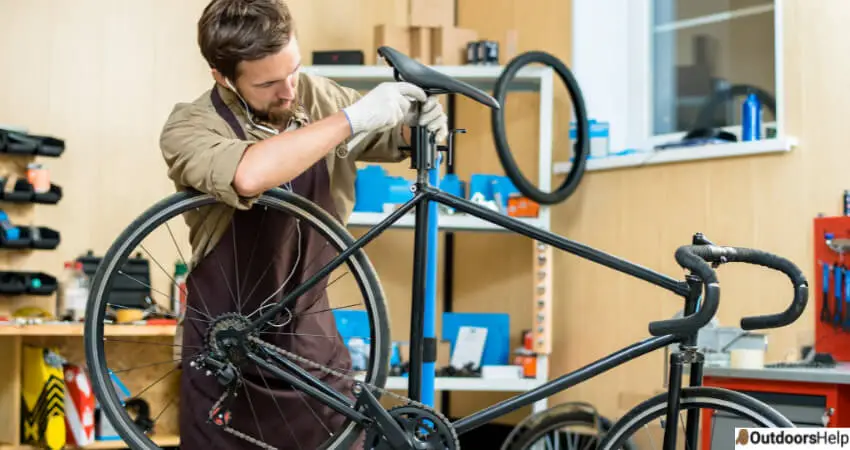Not every bike frame is created equal. Since a frame is the bike’s backbone, it is essential to understand its composition and what that means for cyclists. Frames serve to offer extra strength with minimum weight. Nonetheless, several factors determine the strength of a frame. A double-butted frame means that the ends of the tube are thicker, and a single butted frame implies that only one end is thicker than the middle section. The thickness on the two ends of a butted frame provides additional strength at the junctions but is thin in the middle for saving weight. Read on to find out more about butted frames, which material is suitable for you, and what to look for in a frame.
Which Material To Choose
The material for the frame depends on several factors, including your riding style, weight, and sense of adventure. There are different types of materials commonly used on bicycles. Below are some of the materials.
Carbon Steel
Some bike frames feature steel. Carbon steel is good, durable, and strong, although not as light as Chromoly steel.
Chromoly Steel
Chromoly is a type of steel that’s light and strong. When butted and shaped to get rid of the excess weight, it delivers a reasonably lightweight frame that will last you long enough, even with frequent use. Chromoly steel is responsive while offering good flex as it maintains its form.
Aluminum
Aluminum is also commonly used to make bike frames as it is less expensive, light, strong, and stiff. The material will give a solid ride for climbing and lively handling in challenging situations when appropriately designed.
Titanium
Titanium is lighter than steel but quite strong. The metal can be pretty expensive and is used on high-end road and cross-country mountain bikes. The material flexes so well and maintains its shape that some high-end bicycles use it as a shock absorber.
Carbon Fiber
Carbon fiber can be very tough if appropriately designed. The material is light but can be brittle. Carbon fiber easily bends and regains its shape, thus why it can last long. Carbon fiber frames are stronger than required to ensure that they will bend and regain their shape quickly.
Factors To Consider When Choosing a Frame
Different manufacturing processes and market trends still shape the bicycle frames. Although not common as in the past, the butting process is still applied when manufacturing bicycle frames. Many companies have replaced steel with aluminum since it is hardy and not as expensive as steel. So what do you consider when choosing a frame?
Butting
Manufacturers strive to put the material where it’s needed, and the material is of much use on the areas where the bike frame goes through the most stress at the end of the different tubes. The process is known as butting.
Internal Butting-When you look at the tube, you will not notice butting since it is hidden in the tube. Therefore, if you need to know whether the bike is butted, you will have to ask the manufacturer as this is a huge selling point.
External Butting– External butting refers to adding material on the outside of the tube. Nowadays, manufacturers rarely do this, although sometimes you may notice an extended weld. The two methods commonly used to butt a frame tube include:
1. Double Butting-When shaping the tube, extra material is allowed internally at both ends of the tube. When these tube areas are increased, the overall thickness of the tube wall gets reduced, hence, saving weight.
2. Triple Butting-A triple butted frame will have three different wall thicknesses. Triple butted frame increases durability because of the propensity of the midsection to flex more under load, which decreases the fatigue at the joints, where it will most likely become a problem. The triple-butting technology reduces the weight of the frame by 15%.
Weight
Manufacturers use all types of exotic metals and methods to shave some grams from frame designs. Nonetheless, the cost of your bike determines its weight. If you pay more, you get a bike that weighs less, and if you pay less, you will get a bulkier bike.
Plain-gauge Tubing
Even with advancements in materials, design, and manufacturing processes, the most suitable frame tubing for a bike is the plain gauge. These tubes do not depend on butting, oversizing or exotic blends but are durable, straight, and easy to make; therefore, they are more affordable. Many cycling enthusiasts believe that plain-gauge tubes weigh more than butted tubes. Although this is true, the difference is minimal (3 or 4 pounds). If you only ride in town and do not climb hills and mountains, the weight difference will have no impact.
Your Mass Weight
If you weigh over 170 pounds, you will need a bike with higher strength, which may take an extra pound of frame weight to achieve, although it is worth it. Moreover, steel and titanium metals are better for heavier cyclists because of elongation. These metals can flex more without breaking.
Your budget
Although aluminum and titanium are dropping in price, steel is the cheapest metal. But because most cyclists prefer aluminum and carbon fiber as they are lighter, manufacturers are designing bikes with more affordable aluminum and carbon fiber frames.
Amount Of Time You Will Own The Bike
Steel oxidizes faster than aluminum. Nonetheless, steel will take more stress over the long run than aluminum. Therefore, if you live in wet areas, you may want to consider buying aluminum, and if you live in dry areas, steel will be much better.
Conclusion
Butted is a term commonly used in the bicycle industry. A butted tube means the outside of the tube has a constant diameter, and its wall thickness varies. Double-butted means that the tube’s ends thickness is thicker than in the center area. Therefore, there are two butted sides. Thicker tubes help increase the strength and allow for a better weld in regions of high stress.

